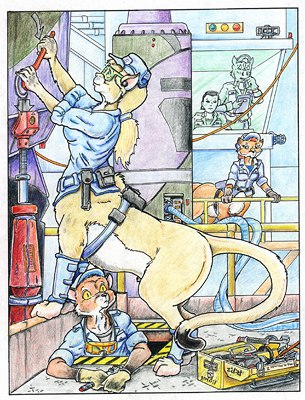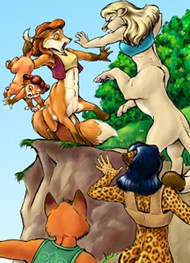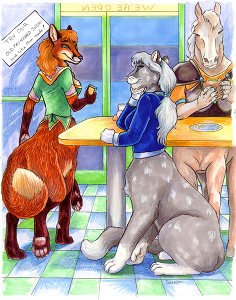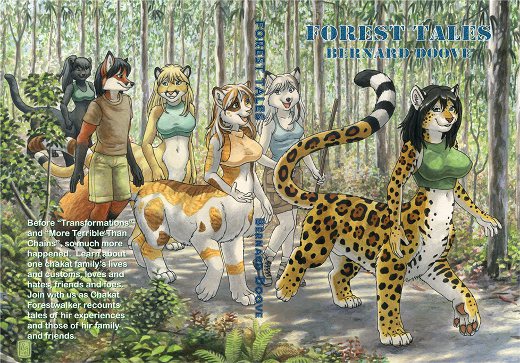Review: 'Forest Tales', by Bernard Doove
Before Transformations and More Terrible Than Chains, so much more happened. Learn about one chakat family’s lives and customs, loves and hates, friends and foes. Join with us as Chakat Forestwalker recounts tales of hir experiences and those of hir family and friends. (back-cover blurb)
Melbourne Furry fan Bernard Doove has been writing his chakat stories on his website “The Chakat’s Den” since 1995. Beginning in 2006 he began compiling his short stories into books, starting with Transformations, Jazmyn, and More Terrible Than Chains, which were story arcs that made separate novels. Now Doove has returned to his earliest stories, which did not.
Forest Tales contains the first twenty-seven stories in that series, redubbed “episodes”, written between 1995 and 2002. There are many more, but the series breaks easily at this point. Doove is the primary author, although four of the twenty-seven were written in collaboration with other authors, and one is written by Christian Neumann.
The Forest Tales were originally illustrated by dozens of different artists on The Chakat’s Den. Doove has included most of the illustrations here, although they have had to be published in black-&-white.
Chakats are Doove’s invention; a futuristic intelligent bioengineered species of centauroid felines with prehensile tails, inhabiting the interstellar planet Chakona. They live in a futuristic universe heavily inspired by Star Trek. The bioengineered chakats and foxtaurs and skunktaurs share an interstellar civilization with humans, other uplifted bipedal animal-peoples such as kangaroos, squirrels, and wolves, and natural two-legged Caitains (cat-men), Voxxans (fox-men), Renzar (ursinoids), and others who come from their own planets. The different species have their own merchant spaceships, and serve together in a common civilian Star Corps and a military Star Fleet, both of the Federation Stellar Services.
Doove’s universe is mildly controversial because of his assumption that nonhuman species would not have human customs. Furry peoples would not need clothing except for such conveniences as pockets, and many besides the humans go about nude. The bioengineered species are hermaphroditic, and the sexual characteristics of both genders prominently hang out.
Doove has created his own hermaphroditic pronouns of “shi”, “hir”, and “Shir”, and the reader just has to get used to them. The most controversial aspect is that the very social chakats, foxtaurs, etc., go into heat and do not have human hang-ups about sexuality. They go into casual mating, triads, love-fests with the whole family including young children, and the like, many of which are actually copied from non-Christian aboriginal customs such as those of the Amazonian and New Guinea tribes; so nobody can say that they could never exist in practice.
Whether Doove handles these aspects tastefully or he throws them in the reader’s face is a matter of personal opinion. At least, nobody can accuse Doove’s worlds of just being bland and unimaginative funny-animal societies.
Forest Tales begins as the personal journal of Chakat Forestwalker.
My jaguar-patterned fur combined with the light and shadow to break up my feline form, making me a barely noticed flicker of movement amongst the dense undergrowth. The barely discernable trail wove between the towering Mountain Ash and stands of tree ferns, turning into a rock-climb in parts. (p. 7)
 The setting is not Chakona, but Australia on Earth. To quote a bit from The Chakat’s Den omitted from this volume,
The setting is not Chakona, but Australia on Earth. To quote a bit from The Chakat’s Den omitted from this volume,
Forest is an expert biologist employed by the Department of Conservation. Hir duties involve surveying the national parks for their wildlife and vegetation, and to keep a watch out for possible environmental problems. Our species tend to excel in these conditions and shi loves hir work. However, this tends to keep hir away from home a lot.
The first few episodes establish Forest’s adventures as an Australian wildlife biologist, including fighting a gang of human-supremacist poachers. Forest’s interstellar-traveling sister Goldfur and hir friend Midnight, a black-furred chakat who is the scout-team leader of the planetary survey team of the starship that Goldfur was last on, are introduced. Everyone has a lot of friendly social sex.
The foxtaur communities on Earth come into the story, and their settings and customs are described in lively and colorful detail. Forest, Goldie, and Midnight are invited to join a foxtaur athletic contest, and Forest is traumatized when shi is unable to save a foxtaur cub from drowning. Forest’s lifemate and Midnight’s commander, Admiral Boyce Kline of the Star Fleet, is introduced. The fact that chakats and humans are not interfertile does not prevent them from loving each other and enjoying sex together.
In a flashback Goldfur describes how shi met hir lifemate, the foxtaur Garrek, when both were serving as engineers on the exploration starship James Cook. Garrek takes over to complete the story, which involves a LOT of sex when they both go into heat.
 Forest Tales turns momentarily dramatic when the foxtaur Ketta becomes insanely jealous of chakats and turns vicious when the other foxtaurs stand up for Forest and their other guests. Ketta is exiled from her foxtaur clan, and her new life with the Quanges (equitaurs) is described. Some ‘taurs are killed by human-supremacist terrorists. And so forth, and so on. The very episodic Forest Tales does not end as much as it leads into Doove’s Transformations.
Forest Tales turns momentarily dramatic when the foxtaur Ketta becomes insanely jealous of chakats and turns vicious when the other foxtaurs stand up for Forest and their other guests. Ketta is exiled from her foxtaur clan, and her new life with the Quanges (equitaurs) is described. Some ‘taurs are killed by human-supremacist terrorists. And so forth, and so on. The very episodic Forest Tales does not end as much as it leads into Doove’s Transformations.
Forest Tales never becomes really dramatic, or very coherent as a novel. It is a string of short tales of Chakat Forestwalker and hir family, friends, and acquaintances. Through them you will get a glimpse of life in the early-mid 24th century (2320s and 2330s) interstellar civilization. Doove has developed this with suggestions and kibitzing from several friends, some of whom have become collaborative writers or illustrators. It is a richly described multispecies society, with the focus upon the ‘taur species and the humans and other two-leggers as background characters.
Doove tries to make each of his chakat-universe books self-explanatory, but Forest Tales is where it all starts. The chakats have many fans, and many who are repelled by their open sexuality. The series, which is covered up to #27 in Forest Tales, is continued in Other Trails Taken; A Chakat Family Journal, Book II (May 2011; review), and Tales from the Chakat Universe (May 2012; review).
About the author
Fred Patten — read stories — contact (login required)a retired former librarian from North Hollywood, California, interested in general anthropomorphics

Comments
Post new comment